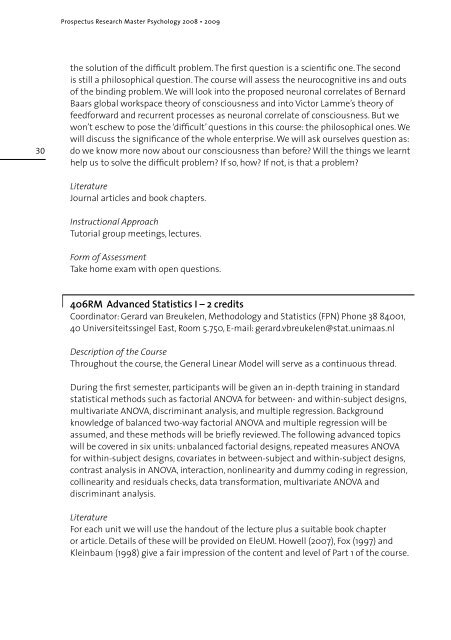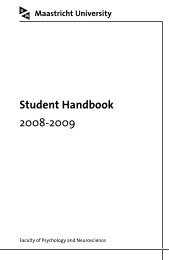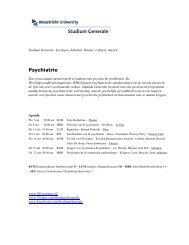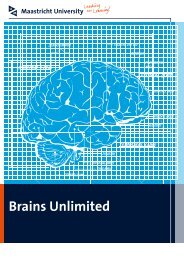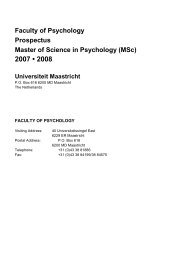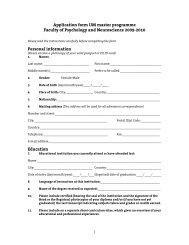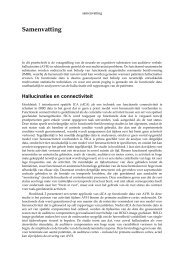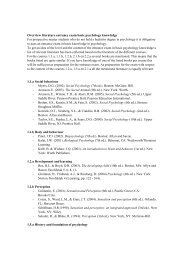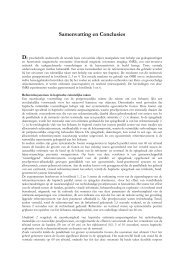Prospectus | 08/09 - Psychology and Neuroscience - Maastricht ...
Prospectus | 08/09 - Psychology and Neuroscience - Maastricht ...
Prospectus | 08/09 - Psychology and Neuroscience - Maastricht ...
Create successful ePaper yourself
Turn your PDF publications into a flip-book with our unique Google optimized e-Paper software.
<strong>Prospectus</strong> Research Master <strong>Psychology</strong> 20<strong>08</strong> • 20<strong>09</strong><br />
30<br />
the solution of the difficult problem. The first question is a scientific one. The second<br />
is still a philosophical question. The course will assess the neurocognitive ins <strong>and</strong> outs<br />
of the binding problem. We will look into the proposed neuronal correlates of Bernard<br />
Baars global workspace theory of consciousness <strong>and</strong> into Victor Lamme’s theory of<br />
feedforward <strong>and</strong> recurrent processes as neuronal correlate of consciousness. But we<br />
won’t eschew to pose the ‘difficult’ questions in this course: the philosophical ones. We<br />
will discuss the significance of the whole enterprise. We will ask ourselves question as:<br />
do we know more now about our consciousness than before? Will the things we learnt<br />
help us to solve the difficult problem? If so, how? If not, is that a problem?<br />
Literature<br />
Journal articles <strong>and</strong> book chapters.<br />
Instructional Approach<br />
Tutorial group meetings, lectures.<br />
Form of Assessment<br />
Take home exam with open questions.<br />
| 406RM Advanced Statistics I – 2 credits<br />
Coordinator: Gerard van Breukelen, Methodology <strong>and</strong> Statistics (FPN) Phone 38 84001,<br />
40 Universiteitssingel East, Room 5.750, E-mail: gerard.vbreukelen@stat.unimaas.nl<br />
Description of the Course<br />
Throughout the course, the General Linear Model will serve as a continuous thread.<br />
During the first semester, participants will be given an in-depth training in st<strong>and</strong>ard<br />
statistical methods such as factorial ANOVA for between- <strong>and</strong> within-subject designs,<br />
multivariate ANOVA, discriminant analysis, <strong>and</strong> multiple regression. Background<br />
knowledge of balanced two-way factorial ANOVA <strong>and</strong> multiple regression will be<br />
assumed, <strong>and</strong> these methods will be briefly reviewed. The following advanced topics<br />
will be covered in six units: unbalanced factorial designs, repeated measures ANOVA<br />
for within-subject designs, covariates in between-subject <strong>and</strong> within-subject designs,<br />
contrast analysis in ANOVA, interaction, nonlinearity <strong>and</strong> dummy coding in regression,<br />
collinearity <strong>and</strong> residuals checks, data transformation, multivariate ANOVA <strong>and</strong><br />
discriminant analysis.<br />
Literature<br />
For each unit we will use the h<strong>and</strong>out of the lecture plus a suitable book chapter<br />
or article. Details of these will be provided on EleUM. Howell (2007), Fox (1997) <strong>and</strong><br />
Kleinbaum (1998) give a fair impression of the content <strong>and</strong> level of Part 1 of the course.


